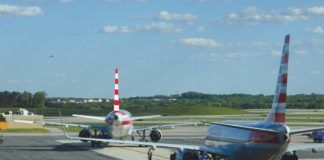During a recent long cross-country, I found myself progressing across vast open spaces in Pennsylvania. I overheard the following.
Unknown aircraft calling Approach: “Ann, is that you?”
Approach: “Jeremy?”
Aircraft: “Yeah, it is me. What time do you get off work? Are you going to the happy hour?”
Approach: “I should be out of here in time. I’ll see you there.”
After a few more exchanges of details about the event, I decided to chime in.
Me: “Guys, can I come?”
Approach: “Sure, but pilots have to pay.”
Me: “Always the case.”
John Moore
Vero Beach, FL
A friend flies for Alaska Airlines. He knows I like the microbreweries of the Pacific Northwest, so he sent me a photo of the panel on the 737 on the approach to Portland—two fixes near one another—”Mycro” and “BBrew”—or “MycroBbrew.” I’m guessing that SSAIL intersection would be for the Full Sail Brewery.
James Hanson
Albert Lea, MN
Many of you are aware of the designated “hot spots” at busy airports for taxiway or runway intersections that might be confusing. They are great for situational awareness, maybe not so great for position reports. I heard the following on Portland Ground frequency:
Cessna 123: “Portland Ground, Cessna 123. Ready for taxi at hot spot 3.”
Portland Ground: “Cessna 123, say again position.”
Cessna 123: “Hot spot 3.”
Portland Ground: “Huhh?…”
Cessna 123 (a different voice): “Cessna 123 is at the FBO, on A4 short of A.”
Portland Ground: “OK that’s better. Cessna 123 taxi to 28R via A.”
I think the CFI was letting his student make a mistake for educational purposes.
Rick Sanders
San Francisco, CA
While flying on the west side of Puget Sound on an instrument-check flight at night, my instructor asked me to do an “emergency diversion.”
I elected to divert to Boeing field. On approach I explained my requests and the tower asked me which level of runway lighting intensity I wanted. Being a new instrument pilot and on a very dark, moonless night, I asked for “high.” The next words out of the controller’s mouthing in a sing song fashion were, “You’re not going to like it.”
After landing I really knew what he meant. They were intensely bright!
Tel Paris
Gig Harbor, WA
Every spring, eastern South Dakota skies are filled with geese as they return home to Canada for summer nesting. On any given day during March more than a million geese, (Snows, Brants, Canadians, and lesser Canadians) can be found roaming stretches of eastern South Dakota. It can get crowded.
I was flying in our Bonanza V-tail from Sioux Falls to Aberdeen this past March at 6000 feet and had just been handed off from Sioux Falls Departure to Minneapolis Center just north of Madison, South Dakota when this exchange took place:
Minneapolis Center: “Bonanza 311BG Minneapolis Center, 4 miles at 11 o’clock, multiple contacts, type, direction and altitude unknown, possible bird targets.”
I responded with receipt of the radar contact and began looking for geese at my altitude or hopefully below me.
After a minute I indicated “no joy” on the geese sighting and added, “It sure would be nice if we could get them to wear transponders.”
Without missing a beat Minneapolis Center responded, “Unlikely, but they do squawk.”
David Zellmer
Sioux Falls, SD
My “copilot” is my very reluctant husband who enjoys getting there, but has no interest in learning anything about the plane, flying, emergency procedures, etc. After 12 years in the air together you would think he would absorb a little bit just by osmosis. I am happy to report that he finally knows the emergency frequency, 121.5. That is because it is now the bathroom code at our hangar association.
Susan Nelson
Kirkland, WA
Please send us your cleverest or most embarrassing moment on the radio—or your favorite fix names or airport names—with a subject of “OTA,” to [email protected]. Be sure to include your full name and location.



